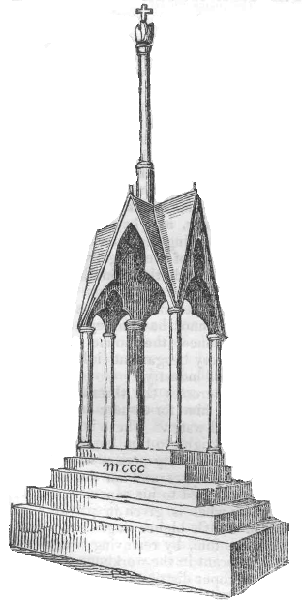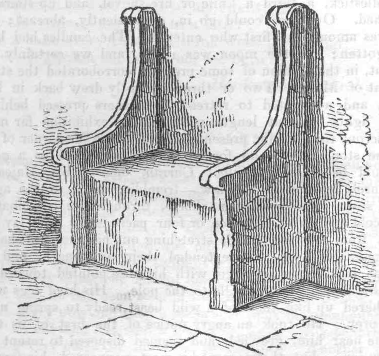Kilkenny
[From the Dublin Penny Journal, Vol. 1, No. 12, September 15, 1832]
As we promised to give some account of that famous city which boasts of having
"Fire without smoke, air without fog,
"Water without mud, and land without bog!"
 we must redeem our pledge, though not perfectly prepared to do it. But Kilkenny will not be forgotten in our future numbers, and therefore the men both of the Irish and English towns need not imagine that we will dismiss their city with the present scanty notice. It is indeed a rich storehouse of antiquities and historical recollections, and our own inclinations will lead us back to it: in the meantime, we know of no better introduction to this article than a view of the ancient Market Cross, which was barbarously removed in the year 1771. Its date was inscribed on the fourth step-mccc.
we must redeem our pledge, though not perfectly prepared to do it. But Kilkenny will not be forgotten in our future numbers, and therefore the men both of the Irish and English towns need not imagine that we will dismiss their city with the present scanty notice. It is indeed a rich storehouse of antiquities and historical recollections, and our own inclinations will lead us back to it: in the meantime, we know of no better introduction to this article than a view of the ancient Market Cross, which was barbarously removed in the year 1771. Its date was inscribed on the fourth step-mccc.
Kilkenny, the capital of the county of the same name, is one of the most elegant cities in the kingdom, and is the largest inland town in Ireland. It is situated on the banks of the Nore, a river noted for the transparency of its waters, and the exquisite beauty of its scenery. Kilkenny has been from the most remote time a place of great importance, and it is more than probable that it is the Ivernis of Ptolemy. But to our mind, there is a modern circumstance connected with this city which is nearly as interesting to us as its antiquity. It is the native city of banim-whose powerful works of fiction have flung back the charge that Ireland is mute, while voices are issuing from the surrounding nations.
Kilkenny consists of two towns, one which is termed the English-town and is larger and better built than the other, which is called the Irish-town. The city is governed by a mayor, recorder, aldermen and sheriffs; the chief magistrate of Irish-town is called a Portrieve. Our readers will remember "the Roman Merchant," which appeared in a late number, and the description of Irish-town which is there given. Kilkenny received several important grants from the English kings, particularly from Edward 1st, Elizabeth, and James 1st, which last made it a city, "for its eminent services against the Irish rebels."
We know not any place in Ireland where the lover of religious antiquities might spend a day so well as in the Cathedral of St. Canice. It is situated on a gentle eminence, and yields to no cathedral in the kingdom, for the beauty and lightness of its architecture, and in size only to Christ's, and St. Patrick's in Dublin. Its shape is cruciform, and consists of a choir, transepts, including Lady Chapel, and nave with lateral isles, presenting a range of arches resting on columns of black marble-but these are now whitened, in consequence of the whim of a foolish economist. The man must have been a Goth, a Vandal, a Hun, but surely not a Celt, who thus defaced these, perhaps to him gloomy pillars, by having them neatly whitewashed. In this beautiful nave are buried the Butlers, the Graces, the Purcells, and the Marshalls. Here also lies Bishop Nicholson, Walsh, who, A.D. 1585, was assassinated in open court by one James Dullard, whom he had cited before him to answer for the crime of adultery. The villain was of such respectable connexions and though brought to justice, and executed for his crime, yet his relatives had interest enough not to permit those crimes to be recorded on marble; and so on the Bishop's tomb it is merely said that he died on the 14th of December, 1585.
 Reader, if ever you go to see St. Canice's Cathedral, ascend its tower; but first of all, go see the stone chair of St. Ciaran, the patron saint of the diocese, and one of the first teachers of Christianity in Ireland. Having gazed on this relic, ascend the tower, and you will have a noble prospect. Immediately beside you one of the finest of the old round towers of Ireland, standing like the creature of other days, and older by seven or eight centuries than every other edifice around. Then adjoining is the Bishop's palace-the library-and pray observe yonder interesting ruin-it is the Dominican Abbey. This abbey consists of two towers and several aisles; and nothing can exceed the lightness of one of those towers, and the beauty of its windows; it contained several tombs, and stone coffins but they are now destroyed; among them were the tombs of sixteen knights, who came over at the conquest of Ireland. The Franciscan abbey lies near the Nore, at the end of the town-wall; part of it still remains, with a handsome light tower, supported on a beautiful arch; some smaller remains are still to be seen. Many think that William, Earl Marshall, who died in Kilkenny, of the wound he received at the Curragh, was buried in this abbey; but Hanmer says he was interred in the Black or Dominican Abbey, and that his tomb was destroyed with many others, at the suppression of the monastery. The Augustinian monastery or priory of St. John, was one of the most beautiful of ruins, and called from the number of its windows, the lanthern of Ireland; it has been injudiciously converted into a parish church in such a way as to destroy its architectural beauty, half the windows having been closed up, apparently to save window glass!! Is this creditable to the taste of Kilkenny?
Reader, if ever you go to see St. Canice's Cathedral, ascend its tower; but first of all, go see the stone chair of St. Ciaran, the patron saint of the diocese, and one of the first teachers of Christianity in Ireland. Having gazed on this relic, ascend the tower, and you will have a noble prospect. Immediately beside you one of the finest of the old round towers of Ireland, standing like the creature of other days, and older by seven or eight centuries than every other edifice around. Then adjoining is the Bishop's palace-the library-and pray observe yonder interesting ruin-it is the Dominican Abbey. This abbey consists of two towers and several aisles; and nothing can exceed the lightness of one of those towers, and the beauty of its windows; it contained several tombs, and stone coffins but they are now destroyed; among them were the tombs of sixteen knights, who came over at the conquest of Ireland. The Franciscan abbey lies near the Nore, at the end of the town-wall; part of it still remains, with a handsome light tower, supported on a beautiful arch; some smaller remains are still to be seen. Many think that William, Earl Marshall, who died in Kilkenny, of the wound he received at the Curragh, was buried in this abbey; but Hanmer says he was interred in the Black or Dominican Abbey, and that his tomb was destroyed with many others, at the suppression of the monastery. The Augustinian monastery or priory of St. John, was one of the most beautiful of ruins, and called from the number of its windows, the lanthern of Ireland; it has been injudiciously converted into a parish church in such a way as to destroy its architectural beauty, half the windows having been closed up, apparently to save window glass!! Is this creditable to the taste of Kilkenny?
The other antiquities are generally religious structures, with the exception of the old Parliament house, which still remains, though in the shape of a modernized house. The room where the parliament met, was a hall forty-nine feet by forty-seven, beneath it was a dungeon twenty feet square which communicated with the hall, by a stone stair, and trap door, an iron door led also into the yard. This was a suitable accompaniment to the building from whence emanated those laws called the Statutes of Kilkenny, by one of which it was enacted that marriage with the "mere Irish" was treason, and that any one using the Irish dress or language should forfeit his lands. The Butts Cross, in the outlets of the town, is of dubious erection, but derives its name from the targets, or butts, at which the townsmen were compelled to shoot, by an act of the Kilkenny parliament. The modern buildings of Kilkenny are in general good, the modern churches are neat structures particularly a Catholic chapel, lately built. The court house is new and elegant; the barracks handsome and commodious; and the two bridges over the Nore, are light and graceful, particularly Johns: they are built of black marble, plentifully obtained about the town. The situation of Kilkenny is so beautiful, the views from the bridges so picturesque, and the air so clear and wholesome, that Mirza Abu, the Persian nobleman, compared it to a paradise.
Outside the town is Bennett's Bridge, where in 1704, the famous review was held by the Duke of Ormond, at which so great was the concourse from all parts of the kingdom, that tents were erected in the fields, not for the army, but for the gentry who flocked thither; when an old officer was obliged to give a crown for a truss of straw to lie on, and an innkeeper made as much in a few days for his beds, as paid the rent of his house for seven years! In fact it became an era, and when a Kilkenny man would express his admiration of any thing, he used to say, "I have not seen any thing like it since the review of Bennett's Bridge!"
